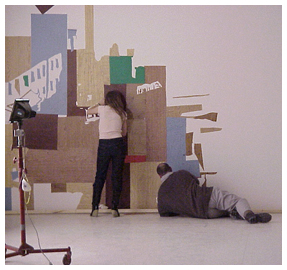


 |


launch interview with Santiago Cucullu
In recent years, Santiago Cucullu has adopted the wall as the primary support for his paintings, working almost exclusively on large, site-specific wall paintings that occupy a space between autobiographical reminiscence, fiction, and collective memories. Drawing from a wide field of references ranging from the novels of Dostoyevsky to the rock band Led Zeppelin (Brothers Karamazov, The Led Zeppelin Saga, both 1998), Cucullu questions the possibility of painting history objectively and examines how specific historical figures have been represented and digested by Western culture.
1978 pt2 (1999) is a mural painting showing a blurred image of the Argentinean soccer team that won the World Cup in 1978 amid rumors that Peru might have been illicitly induced to throw the final match. It is a "souvenir" of the artist's childhood, and it suggests a larger historical context: the imposed military dictatorship of General Jorge Videla that made the political situation in Argentina unbearable for many. By bringing to our attention an "off-center," long-forgotten event, Cucullu gives a voice to the subaltern.
Abstract Yet Riel and Individual (2000) depicts a historic tale of resistance involving Louis Riel, a heroic leader and early organizer of the Métis, Canadians of mixed ancestry. In this mural, Cucullu combines appropriated fantastic images of a mounted warrior by illustrator Frank Frazetta with representations of land-surveying equipment. Both refer symbolically to the early conflict between the native populations and the colonizing powers that annexed their land. Although this episode in history takes place in a specific geographic location, it resonates with larger issues surrounding the position of the marginalized in relation to the structures of power.
For Cucullu, history is an uncertain system of fallible truths. And yet he embraces, and challenges, one of the most disregarded genres in painting, namely, history painting. In his latest series of works exploring the death penalty in America (And do they kiss? They try, Capital punishment machines fucking, both 2002), he is acutely aware that to challenge such a genre he must avoid anything that sounds like a voice of authority. For him, there is no more truth in painting than there is in history.
Before moving to Houston, Cucullu resided in Minneapolis, Minnesota, where his work has been shown at Franklin Art Works (2002), the Soap Factory (2000), and the Walker Art Center in Dialogues: Bonnie Collura/Santiago Cucullu (2000). His work has been included in a number of group exhibitions, including Officina America, Bologna, Italy (2002); Fresh: The Altoids Collection (traveling through 2002); and "Pictures" at an Exhibition, Artists Space, New York, New York (2001).
--Philippe Vergne











